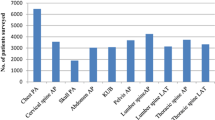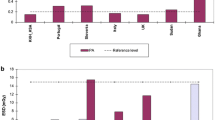Abstract
Background
Ionizing radiation has a detrimental effect on the human body, particularly in children. Thus it is important to minimize the dose. Linear slit-scanning X-ray units offer the possibility of dose reductions. In order to further develop linear slit-scanning radiography, the dose needs to be accurately calculated for various examinations.
Objective
To measure the entrance dose (free-in-air) and calculate the effective doses for various radiological examinations in children on Lodox Statscan and Shimadzu radiography units.
Materials and methods
Entrance doses (free-in-air) were measured using a dose meter and ionization chamber on the Statscan and Shimadzu units at two South African hospitals. The entrance doses were measured for a number of common examinations and were used to compute the effective dose using a Monte Carlo program.
Results
The standard deviation of the entrance doses was in the range 0–0.6%. The effective dose from the Statscan unit was well below that from the Shimadzu unit as well as that found in other radiological studies from around the world in children. The one exception was chest examination where the dose was similar to that in other studies worldwide due to the use of Chest AP projection compared to Chest PA used in the comparitive studies.
Conclusion
Linear slit-scanning systems help reduce the dose in radiological examinations in children.

Similar content being viewed by others

References
ICRP (1991) 1990 Recommendations of the International Commission on Radiological Protection. Ann ICRP 21:1–201
Slovis TL (2002) CT and computed radiography: the pictures are great, but is the radiation dose greater than required? AJR 179:39–41
Roebuck DJ (1999) Risk and benefit in paediatric radiology. Pediatr Radiol 29:637–640
Beningfield S, Potgieter H, Nicol A et al (2003) Report on a new type of trauma full-body digital x-ray machine. Emerg Radiol 10:23–29
Lodox Systems (2006) STATSCAN critical imaging system – product specifications and physical dimensions. Technical publication. Lodox Systems, Johannesburg, South Africa
Pitcher RD, van As AB, Sanders V et al (2007) A pilot study evaluating the “STATSCAN” digital x-ray machine in paediatric polytrauma. Emerg Radiol EMRAD-07-00057 (in press)
Tapiovaara M, Lakkisto M, Servomaa A (1997) PCXMC: a PC-based Monte Carlo program for calculating patient doses in medical X-ray examinations. Report STUK-A139. Finnish Centre for Radiation and Nuclear Safety, Helsinki
Schultz FW, Geleijns J, Speolstra FM et al (2003) Monte Carlo calculations for assessment of radiation dose to patients with congenital heart defects and to staff during cardiac catheterizations. Br J Radiol 76:638–647
Hansen J, Jurik AG, Fiirgaard B et al (2003) Optimisation of scoliosis examinations in children. Pediatr Radiol 33:752–765
Compagnone G, Pagan L, Bergamini C (2005) Effective dose calculations in conventional diagnostic X-ray examinations for adult and paediatric patients in a large Italian hospital. Radiat Prot Dosimetry 114:164–167
Geleijns J, Broerse JJ, van Vliet M et al (2000) Assessment of effective dose in paediatric radiology: a survey at 14 Dutch hospitals. Radiat Prot Dosimetry 90:135–140
Mohamadain K, da Rosa L, Azevedo A et al (2004) Dose evaluation for paediatric chest x-ray examinations in Brazil and Sudan: low doses and reliable examinations can be achieved in developing countries. Phys Med Biol 49:1017–1031
Gogos KA, Yakoumakis EN, Tsalafoutas IA et al (2003) Radiation dose considerations in common paediatric x-ray examinations. Pediatr Radiol 33:236–240
Potgieter H, de Villiers M, Scheelke M et al (2005) An explanation for the extremely low, but variable radiation dosages measured in a linear slit scanning radiography system. Medical Imaging 2005: Physics of Medical Imaging 5745:1138–1145
Acknowledgements
This research is supported in part by the National Research Foundation of South Africa and the University of Cape Town.
Author information
Authors and Affiliations
Corresponding author
Rights and permissions
About this article
Cite this article
Maree, G.J., Irving, B.J. & Hering, E.R. Paediatric dose measurement in a full-body digital radiography unit. Pediatr Radiol 37, 990–997 (2007). https://doi.org/10.1007/s00247-007-0565-3
Received:
Revised:
Accepted:
Published:
Issue Date:
DOI: https://doi.org/10.1007/s00247-007-0565-3



